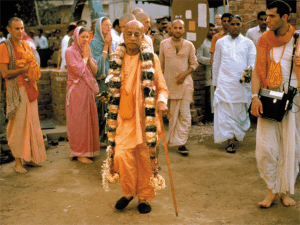Newly wed disciple...
Kulasekhara dasa: A newly wed disciple once approached Srila Prabhupada for advice about marriage and got a puzzling reply. Srila Prabhupada had himself performed a fire yajna ceremony for the young man and woman in his London temple, and the next morning the newlyweds managed to accompany Srila Prabhupada alone on his morning walk. The husband walked next to Prabhupada and the wife walked three paces behind. "Prabhupada, what does it mean to be married in Krishna consciousness?" Prabhupada was silent for a moment and then said, "To be married in Krishna consciousness means that before you eat your prasadam, you go out in the street and you call three times loudly, Does anyone want to take prasadam? Does anyone want to take prasadam? Does anyone want to take prasadam?' If no one comes, then you take your prasadam." The husband felt somewhat bewildered, because he was hoping to hear direction about the position of a married couple and how they should deal intimately in relating with each other. The young man thought that perhaps Prabhupada had not understood him, so near the end of the walk he again asked the same question. "Prabhupada, what does it mean to be married in Krishna consciousness?" Prabhupada steadily repeated his answer, "To be married in Krishna consciousness means that before you take prasadam, you go out into the street and you call loudly three times, Does anyone want to take prasadam?' If no one comes, then you take prasadam."
We should not be like this neophyte Krishna conscious grihastha and be puzzled by Prabhupada's advice for the householders. In his memoir, the devotee states that he thought Prabhupada didn't understand him, Prabhupada understood perfectly. He also gave advice for the bonafide behavior of the grihastha. There are full instructions for the grihastha given in the Seventh Canto of Srimad-Bhagavatam, and these few words spoken by Prabhupada are among the scriptural directions for household life. We cannot say why Srila Prabhupada chose to give exactly these instructions and only these instructions. First of all, however, the new householders should accept that Prabhupada's instructions are sastric, and secondly, they should try to think why Prabhupada has chosen to give these particular instructions. He did not arbitrarily select from the many scriptural instructions. The particular instruction Srila Prabhupada gave that a householder should not just make an arrangement for his own sense gratification in eating but should share it with others first stresses that the grihastha-asrama is a renounced way of life. The young householder admitted that he wanted to hear from Prabhupada about the intimate dealings of husband and wife, but Prabhupada pointed out that that is not what grihastha life is about. According to the varnasrama system, the grihastha is actually the material provider of the whole society. A neophyte devotee may think that if he gets married, he can make a better arrangement for an independent life of eating and being comfortable, which he could not arrange so nicely as a brahmacari. The particular instruction that Prabhupada chose to give cuts this misconception to pieces. Rather than become a sense enjoyer once married, the grihastha is seen here as one who has to carry a burden for all human beings and even other living creatures. This is a picture of a householder not making arrangements for enjoyment, but getting up from his table and going out to provide for others before he takes his own meals. Whatever instruction Srila Prabhupada gave, however odd or puzzling it may have seemed in context, was certainly scriptural, and if one thinks about it carefully, he will see how the teaching applies perfectly to his own case. When acted upon, it will bring success. In Prabhupada Nectar, we see Prabhupada giving particular instructions to particular persons. We may say that these instructions do not have to be universally applied, but at least in every case they are absolute instructions. It is a test of every sincere disciple whether he followed the instructions Prabhupada gave him. We have already cited this point in connection with Prabhupada's warnings to the devotee-artist who was developing sahajiya symptoms. Reading anecdotes about Srila Prabhupada's practical instructions, we can appreciate the particular instructions he gave different persons and we can imbibe the general instruction: that one should always respect, meditate on, and carry out the instructions he or she received from the spiritual master.
